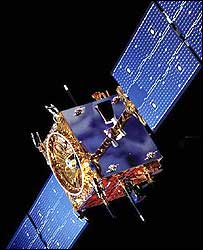High expectations for the first European mission to the moon * Criticism in India for the expenditure
Avi Blizovsky

The Smart-1 spacecraft will use solar collectors not only for electricity but also for propulsion
Direct link to this page: https://www.hayadan.org.il/moon190803.html
A new engine based entirely on solar energy will be at the center of the first ever European mission to the moon. This was announced by the project managers. They said that the ion engine is turning from science fiction to real science and will revolutionize spaceflight by propelling spacecraft at higher speeds and over greater distances.
Once the unmanned spacecraft, of course, called Smart-1 reaches orbit around the moon, it will use technology developed in Britain to map the entire surface of the moon for the first time.
The European Space Agency hopes that the mission will help create a better understanding of how the moon was formed and provide more data about its cover.
At a press conference held last Monday (August 18, 2003), the agency's personnel said that the spacecraft will be launched on an Ariane 5 rocket on September 4 from French Guiana. However, a few hours later it was announced that the launch would be postponed to allow other teams to use the rocket to launch their satellites.
The ion engine has been tested only once so far - in NASA's "Deep Space 1" spacecraft, and the team of the European Space Agency will provide an opportunity for another test of the technology.
Solar collectors will provide power to the ion engine, which scientists hope will be enough to accelerate the spacecraft to speeds greater than those possible with a conventional rocket engine. Ion engines are also 10 times more efficient than a rocket engine and can cut the time needed for interplanetary flights.
Sir Patrick Moore says: "This is a pioneering method of propulsion. Ion propulsion is the way space travel will be carried out in the future. This is a pioneering vehicle. Smart (as his name) in every sense."
After 15 months in which the spacecraft will conduct a survey of the moon, the tool, the size of a washing machine, will be used to create an X-ray map of the moon's surface in an attempt to find out exactly how it was formed.
The technology for this was designed by scientists from the Universities of London, Sheffield and Manchester.
A common idea is that the Moon was formed when a Mars-sized object collided with the nascent Earth, and the debris thrown into space by the collision coalesced to form the Moon. If this were the case, the Moon might contain less iron than the Earth, since the Earth's surface contains mostly lighter metals such as magnesium and aluminum. By measuring the amount of these chemical elements for the first time in a comprehensive way, Smart 1 will be able to provide the answer.
quick task
Prof. Manuel Grande, a senior British scientist in the project, described the task as "many preliminary things wrapped together in one task". "This is the first European mission to the moon, it is the first small and fast mission and it is also the first solar powered spacecraft," said the professor from the Rutherford Appleton Laboratory in Oxfordshire.
The lunar rover was supposed to take off in March of this year, but it was postponed due to some malfunctions in the Ariane 5 rockets, and in particular after the big malfunction that happened last December. The accident led to a reshuffle of the Ariane 5 launcher program and some of the European Space Agency's missions were put on hold.

ion engine
* An ion engine uses electrical energy supplied to it through solar collectors to increase the speed of the aircraft.
* Smart-1 uses xenon gas, a colorless gas.
* Electrons are trapped inside a cell using a magnetic field and collide with the zenon atoms. They form xenon ions and more electrons.
* The result is an ion beam that pushes the spacecraft forward
* The impulse created is equal to the pressure created by a sheet of paper held in the palm of the hand.
* Over a long period of time he can make the spaceship travel at high speed.
India will send a spacecraft to the moon by 2008
The Prime Minister announced that India "is ready to take a big step in science"; Those who oppose the idea: the task is not necessary for the poor nation
By: Walla system!
India will send an unmanned spacecraft to the moon by 2008 - Prime Minister Atal Bihari Vajpayee announced this weekend. "India is ready to take a big step in science," said Vajpayee in his speech to the nation on the occasion of Independence Day. "I am happy to announce that before 2008 India will send a mission to the moon". The mission was named "The First Voyage to the Moon", and will cost the country about 80 million dollars.
CNN reported that the idea of sending a spacecraft to the moon was first raised by the Indian Space Agency three years ago and the agency began testing its implementation in 2001.
India wants to register success in space exploration as a matter of pride for the poor country, where millions of residents are homeless and uneducated. However, opponents of the proposal said the mission was not necessary for the impoverished nation because it would not yield new scientific achievements.
Only the US, Russia and Japan have sent spacecraft to the moon so far. China plans to send an unmanned spacecraft to the moon in the next three years.
New!!!! Idan the moon
For news about the European Space Agency on the BBC
For news about India on CNN
https://www.hayadan.org.il/BuildaGate4/general2/data_card.php?Cat=~~~608471618~~~15&SiteName=hayadan
